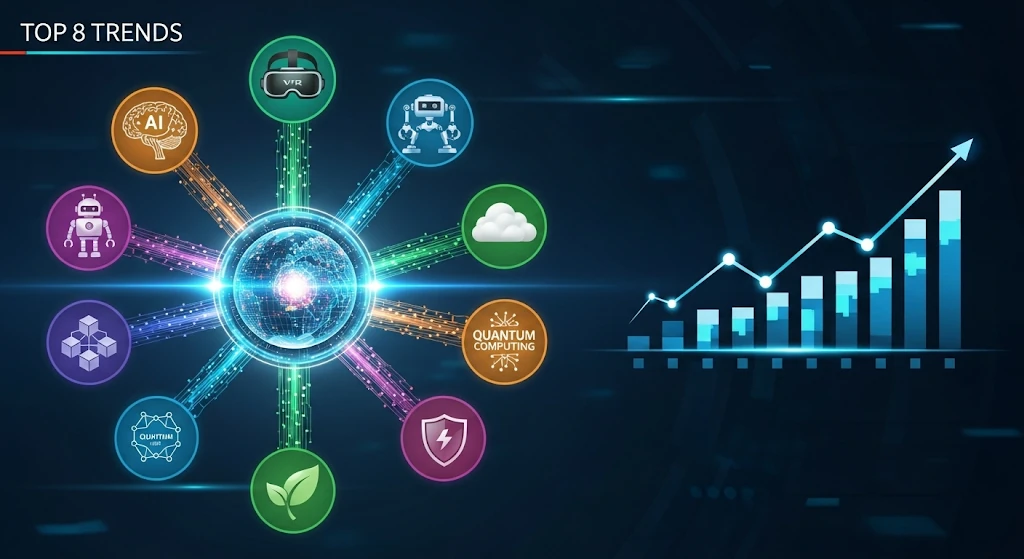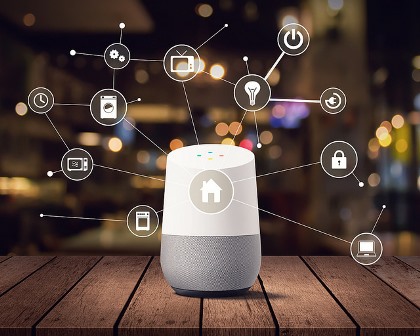
In this rapidly advancing era, new technology trends and inventions are being introduced every day. It seems incredible, how the VCRs that were once considered high-tech equipment have totally become obsolete now. Also, there existed a world without internet and cell phones which have become indispensable today.
From drones being used for security surveillance to Artificial Intelligence and robots being the talk of every town, technology has progressed now more than ever before. The ‘future’, always prophesised is not only here, it is making swift headway.
The list of top 8 trends, ruling the tech industry is as follows:
- Cloud Computing
- Digital Prototyping
- Advancements in UI/UX
- Cybersecurity
- Technology in Healthcare
- Blockchain
- Artificial Intelligence
- Digital Assistants
1. Cloud Computing
Year 2018 has seen a considerable rise in the adoption of cloud computing. It is a method of providing computer programs, software storage and numerous other IT resources through a virtual cloud platform connected via internet.
Cloud computing has commenced from storing only personal data on an external platform to entire organisations shifting their data to the cloud. This technology has brought about a paradigm shift in the way organisations operate. It is not only saving up on time and money, but also giving businesses greater flexibility in managing their data. Public cloud platforms and applications are anticipated to grow at the rate of 22% by the year 2020.
2. Digital Prototyping
Digital prototyping is primarily building a working simulation of the actual application, prior to making the final product. This permits designers to effectually visualise, optimise and redesign their product digitally while saving up on the cost and time of making the actual software.
As developing software is pricey, more and more businesses are adopting digital prototyping as a way of providing better quality and efficiency. Starting from the days of developing the actual software right away, to first making digital prototypes, prototyping has changed the face of the design industry. Digital prototyping has opened the doorway to intuitive UI/UX design by offering user-friendly UI/UX models, and rapid user testing and remodeling.
3. Advancements in UI/UX
The rapidly evolving technology demands user interfaces (UI) and user experiences (UX) to improve continually. Known as the “front end”, the User Interface is the way in which users and computers interact with one another through the use of various hardware and software.
The coming times will call for enhanced User Experiences through better User Interface. Although both UX and UI work in tandem, the concepts are distinct. While User Interface is what is evident to the user at the front end, User Experience is a broader expression and intends to boost the overall experience of the user visiting the website or using the application.
The future is beaming to showcase even better, user-friendly, and accessible voice-assisted interfaces along with larger, vibrant, displays.
4. Cyber-security
As we approach 2019, companies have started focusing more on enforcing cyber-security laws. The General Data Protection Regulation (GDPR) is one of the most discussed topics of the year.
GDPR is a robust regulation which affects any organisation that targets or retains information acquired from European Union residents. This regulation demands that companies develop and implement an opt-in privacy structure and security measures, and in case an individual’s data is compromised, they must reveal this fact to the user within 72 hours.
Despite GDPR being a European law, U.S. based organisations, holding the personal information of EU citizens are also impacted. The penalties for non-compliance include a hefty fine of 2% of a company’s total annual revenue, up to 10 million euros. Although the law was implemented on May 25, 2018, many companies have just started to realise the consequences of these regulations.
The principal elements of GDPR, such as multi-factor authentication, active monitoring and encryption should be in practice to strengthen cyber-security.
5. Technology in Healthcare
Medical professionals and patients’ recent improved connection cannot undermine the crucial need for implementing personlised care in health field, hence leading to emergence of digital health solutions.
Gradual increase and development in mobile solutions considerably comprise of mobile apps meant for monitoring health and telemedicine. According to the IDC predictions report, there is an expected rise of 50% in digital mobile engagement by 2019.
Furthermore, telehealth is predicted to maintain its place in healthcare. The Consumer Telehealth 2016 Benchmark Survey revealed that 83% of respondents rated telehealth as a high priority. Also, some 76% of hospitals are now providing consumer telehealth facilities.
With tools like predictive analysis and image recognition, Artificial Intelligence systems prove to be useful in diagnosing illnesses and special health conditions. Moreover, the first FDA-approved gene therapy has recently hit the market asserting treatment of patients with a rare form of inherited vision loss.
6. Artificial Intelligence
Artificial intelligence (AI) is the latest technological frontier over which companies are competing for control. Pure automation is no longer serving the purpose, and AI is required to enhance data analytics. As per the recent report by McKinsey, around $30 billion have been invested by Alphabet for developing AI systems.
Companies like Amazon Robotics are employing a combination of artificial intelligence and robotics to provide large retailers with unparalleled logistics solutions. Moreover, conventional automakers like Audi has already introduced self-driving vehicles, in competition with Tesla. DARPA is also collaborating with Boston Dynamics to create a series of robots designed for “disaster relief,” while the technology can be used for warfare as well.
Machine-learning technology is seeking to recognise and analyse illnesses to produce new drugs and treatments at a portion of the time and cost. As far as AI security is concerned, legislative boards, as prompted by regulators and activists, will make ethical AI a top priority.
7. Blockchain
Blockchain is a digitised, decentralised, public ledger of all cryptocurrency transactions. It is continuously rising as ‘completed’ blocks (the latest purchases) are recorded and inserted in chronological order. Blockchain technology allows market members to keep a record of their digital currency transactions without any central bookkeeping system.
Initially developed as an accounting system for the virtual currency Bitcoin, blockchains are finding their use in a range of current commercial applications. Many platforms now allow users to buy LTC with PayPal as this cryptocurrency gains popularity alongside Bitcoin. Presently, the technology is mainly used to verify transactions within digital currencies, when it could also potentially work to digitise and virtually add any file into the blockchain. Doing so creates a fixed record that cannot be changed, and whose genuineness can be proved by the whole blockchain community instead of a single, centralised body.
The future holds widespread acceptance of cryptocurrencies and considerable growth for companies providing blockchain products.
8. Digital Assistants
When discussing technology trends, digital assistants cannot be missed out.With drastic sales of intelligent assistants like Google Home and Apple Airpod, we can see that tens of millions of users are interacting with technology through speech today. According to an estimate, more than 20 million Amazon Echo devices were sold last year.
Consumers are now expected to become even more used to voice-based interfaces, as smart assistants are making their way into computers, smartphones, and even televisions. Alexa and Google Assistant have gotten more advanced over the year, with added features like multi-user support.

Amazon plans to have Echo on every office desk alongside Alexa for Business. This will let companies set up voice procedures for things like video conferencing and administer the Alexa commands that employees can use. It also ventures into enterprise services such as Microsoft Exchange, Salesforce, and SAP Concur.
Conclusion
The world has come a long way in a short span of 20 years when internet was first made available commercially. Since then, technology has permeated every facet of our lives. From saving our data on the cloud to checking our medical records on our phones, and from using digital currencies to having digital assistants make calls for us, technology trends have advanced enormously. With the passage of time, we are getting significantly dependent on technology to make our lives comfortable. Only time will tell where this dependency will lead us to.


